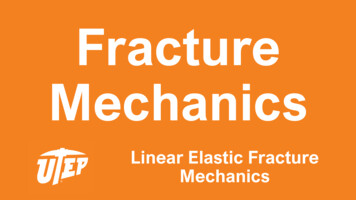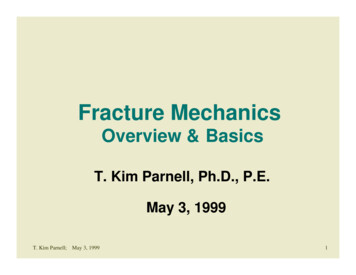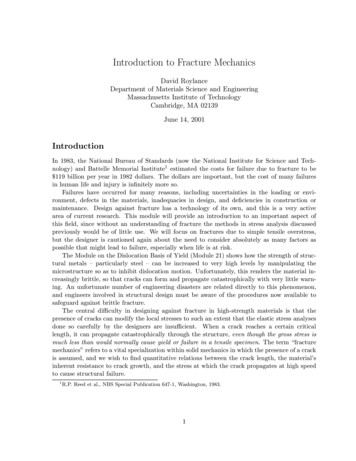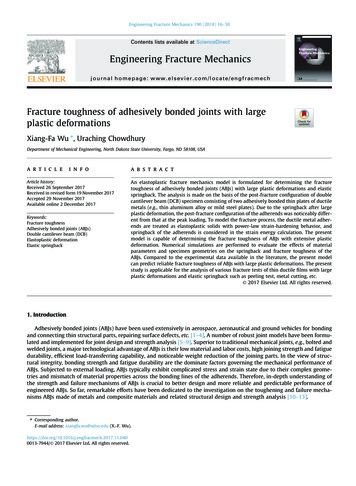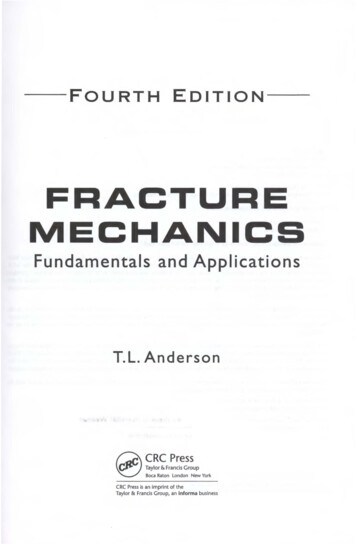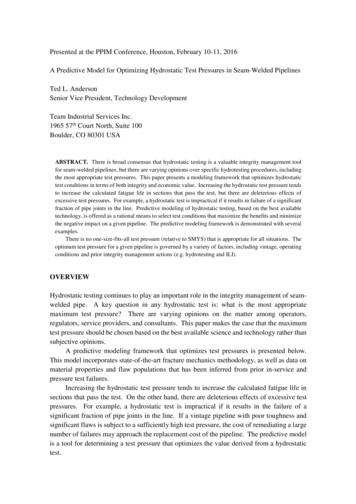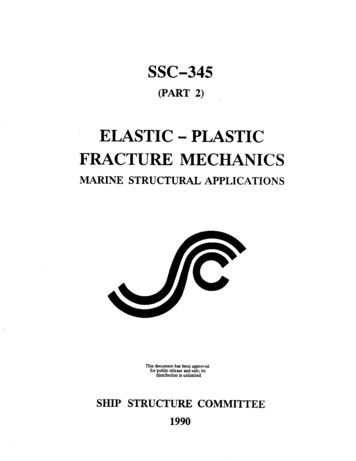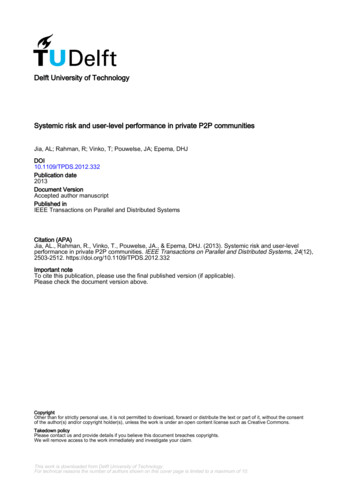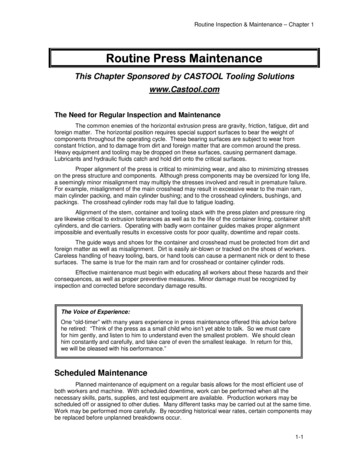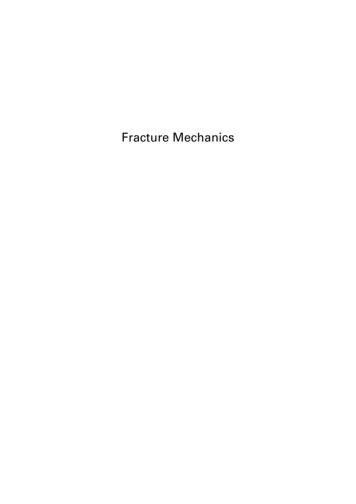
Transcription
Fracture Mechanics
Fracture Mechanics2nd EditionM. Janssen, J. Zuidema and R. J. H. WanhillVSSD
VSSDSecond edition 2002-2006Published by:VSSDLeeghwaterstraat 42, 2628 CA Delft, The Netherlandstel. 31 15 278 2124, telefax 31 15 278 7585, e-mail: hlf@vssd.nlinternet: http://www.vssd.nl/hlfURL about this book: http://www.vssd.nl/hlf/m004.htmA collection of digital pictures and an elctronic version can be made available for lecturers who adoptthis book. Please send a request by e-mail to hlf@vssd.nlAll rights reserved. No part of this publication may be reproduced, stored in a retrieval system, ortransmitted, in any form or by any means, electronic, mechanical, photocopying, recording, orotherwise, without the prior written permission of the publisher.ISBN 90-407-2221-8 EAN 9789040722219NUR 971Keywords: fracture mechanics
vContentsPreface to the First Edition . ixPreface to the Second Edition . xiPart I Introduction1An Overview . 31.11.21.31.41.51.61.71.81.91.101.11About this CourseHistorical ReviewThe Significance of Fracture MechanicsThe Griffith Energy Balance ApproachIrwin’s Modification to the Griffith TheoryThe Stress Intensity ApproachCrack Tip PlasticityFracture ToughnessElastic-Plastic Fracture MechanicsSubcritical Crack GrowthInfluence of Material Behaviour335811121415161820Part II Linear Elastic Fracture Mechanics2The Elastic Stress Field Approach . on of the Mode I Elastic Stress Field EquationsUseful ExpressionsFinite Specimen WidthTwo Additional Important Solutions for Practical UseSuperposition of Stress Intensity FactorsSome Remarks Concerning Stress Intensity Factor DeterminationsA Compendium of Well-Known Stress Intensity Factor SolutionsBibliography252637414548505259Crack Tip Plasticity. 613.13.23.33.43.53.63.7IntroductionThe Plastic Zone Size According to IrwinThe Plastic Zone Size According to Dugdale: The Strip Yield ModelFirst Order Approximations of Plastic Zone ShapesThe State of Stress in the Crack Tip RegionStress State Influences on Fracture BehaviourSome Additional Remarks on Plastic Zone Size and Shape Determination61626571737680
viContents3.8482The Energy Balance Approach . tionThe Energy Balance ApproachRelations for Practical UseDetermination of Stress Intensity Factors from ComplianceThe Energy Balance for More Ductile MaterialsSlow Stable Crack Growth and the R-Curve ConceptA Possible Explanation for the Rising R-CurveCrack Resistance: a Complete DescriptionBibliography83839093969799101105LEFM Testing . 1075.15.25.35.45.55.65.7IntroductionPlane Strain Fracture Toughness (KIc) TestingPlane Stress Fracture Toughness (Kc) Testing: the Feddersen ApproachThe Determination of R-CurvesAn Engineering Approximation to Account for the Effects of Yield Strengthand Specimen Thickness on Fracture Toughness: Anderson’s ModelPractical Use of KIc, Kc and R-Curve DataBibliography107108115120125127129Part III Elastic-Plastic Fracture Mechanics6Basic Aspects of Elastic-Plastic Fracture Mechanics . ment of Elastic-Plastic Fracture MechanicsThe J IntegralRemarks Concerning the J Integral ConceptJ as a Stress Intensity ParameterThe Crack Opening Displacement (COD) ApproachRemarks on the COD ApproachRelation Between J and CTODBibliography133135136147148149151151154EPFM Testing . 1557.17.27.37.47.57.67.7IntroductionThe Original JIc Test MethodAlternative Methods and Expressions for JThe Standard JIc TestThe KIc Specimen Size RequirementThe Standard Gtcrit TestBibliography155155157163171173177
Contents8viiFailure Assessment Using EPFM . 1798.18.28.38.48.5IntroductionThe COD Design CurveStable Crack Growth and Ductile Instability described by JThe Failure Assessment Diagram: CEGB R6 ProcedureBibliography179179184191203Part IV Fracture Mechanics Concepts for Crack Growth9Fatigue Crack Growth. ion of Fatigue Crack Growth Using the Stress Intensity FactorThe Effects of Stress Ratio and Crack Tip Plasticity: Crack ClosureEnvironmental EffectsPrediction of Fatigue Crack Growth Under Constant Amplitude LoadingFatigue Crack Growth Under Variable Amplitude LoadingPrediction of Fatigue Crack Growth Under Variable Amplitude LoadingFatigue Crack 0 Sustained Load Fracture . -Failure (TTF) TestsCrack Growth Rate TestingExperimental ProblemsMethod of Predicting Failure of a Structural ComponentPractical Significance of Sustained Load Fracture TestingBibliography24524624825125325425811 Dynamic Crack Growth and Arrest. ic Aspects of Dynamic Crack GrowthBasic Principles of Crack ArrestFracture Mechanics Analysis of Fast Fracture and Crack ArrestDetermination of the Crack-Arrest ToughnessDetermination of Dynamic Stress Intensity FactorsApproaches in Elastic-Plastic Dynamic Fracture MechanicsBibliography259259263267272275278280Part V Mechanisms of Fracture in Actual Materials12 Mechanisms of Fracture in Metallic Materials . 28512.1 Introduction12.2 The Study of Fracture Surfaces12.3 Slip, Plastic Deformation and Dislocations285286291
viiiContents12.412.512.612.712.812.9Ductile Transgranular Fracture by Microvoid CoalescenceBrittle Transgranular Fracture (Cleavage)Transgranular Fracture by FatigueIntergranular FractureTypes of Sustained Load FractureBibliography29429830130630831513 The Influence of Material Behaviour on Fracture Mechanics Properties 31713.113.213.313.413.5IntroductionThe Effects of Crack Tip GeometryThe Effects of Fracture Path and MicrostructureFracture Mechanics and the Mechanisms of FractureBibliography317318324329357Index . 361
ixPreface to the First EditionWhile teaching a course on fracture mechanics at Delft University of Technology wediscovered that although there are a few excellent textbooks, their subject matter coversdevelopments only up to the early 1970s. Consequently there was no systematic treatment of the concepts of elastic-plastic fracture mechanics. Also the description of fracture mechanics characterisation of crack growth needed updating, especially for sustained load fracture and unstable dynamic crack growth.In the present textbook we have attempted to cover the basic concepts of fracturemechanics for both the linear elastic and elastic-plastic regimes, and three chapters aredevoted to the fracture mechanics characterisation of crack growth (fatigue crackgrowth, sustained load fracture and dynamic crack growth).There are also two chapters concerning mechanisms of fracture and the ways inwhich actual material behaviour influences the fracture mechanics characterisation ofcrack growth. The reader will find that this last topic is treated to some way beyond thatof a basic course. This is because to our knowledge there is no reference work that systematically covers it. A consequence for instructors is that they must be selective here.However, any inconvenience thereby entailed is, we feel, outweighed by the importanceof the subject matter.This textbook is intended primarily for engineering students. We hope it will be useful to practising engineers as well, since it provides the background to several new design methods, criteria for material selection and guidelines for acceptance of weld defects.Many people helped us during preparation of the manuscript. We wish to thank particularly J. Zuidema, who made vital contributions to uniform treatment of the energybalance approach for both the linear elastic and elastic-plastic regimes; R.A.H. Edwards, who assisted with the chapter on sustained load fracture; A.C.F. Hagedorn, whodrew the figures for the first seven chapters; and the team of the VSSD, our publisher,whose patience was sorely tried but who remained unbelievably co-operative.Finally, we wish to thank the National Aerospace Laboratory NLR and the Boilerand Pressure Vessel Authority ‘Dienst voor het Stoomwezen’ for providing us the opportunity to finish this book, which was begun at the Delft University of Technology.H.L. EwaldsR.J.H. WanhillSeptember 1983
xiPreface to the Second EditionIn 1991, the fifth reprint of the first edition of the textbook “Fracture Mechanics”, byH.L. Ewalds and R.J.H. Wanhill, was published. Obviously the field of fracture mechanics has developed further since that time. A new edition was needed. The task fellmainly to the new authors, M. Janssen and J. Zuidema, both in the Department of Materials Science at Delft University of Technology, with assistance by R.J.H. Wanhill, ofthe National Aerospace Laboratory NLR. The original first author, H.L. Ewalds, indicated that he no longer wished to be involved with this textbook. We respect his decision, and thank him for his major contribution to the First Edition, which has been verysuccessful.This second edition is the result of numerous revisions, updates and additions. Thesewere driven by the ongoing development of fracture mechanics, but also by teaching thecourse on fracture mechanics at Delft University of Technology. The fracture mechanicsparameters K, G and J are now treated in a more basic manner. Test methods for JIc andfor crack arrest toughness are updated. The development of failure assessment based onelastic-plastic fracture mechanics is reflected in a comprehensive treatment. On thesubject of subcritical crack growth more attention is paid to the important topic of theinitiation and growth of short fatigue cracks.Throughout the book some paragraphs are typeset in a smaller font. This text is intended to provide additional background information on certain subjects, but is not considered essential for a basic understanding.We would like to acknowledge the assistance of colleagues in preparing this secondedition. With critical reading and profound discussions A.R. Wachters helped considerably in drawing up the part on the J integral. G. Pape did the preparatory work necessary for updating the chapter on dynamic fracture. A. Bakker contributed to the treatment of the R6 failure assessment procedure. Finally, A.H.M. Krom provided usefulcomments and suggestions on various subjects.The authors wish to thank our publisher, J.E. Schievink of the VSSD, for his encouragement and co-operation in creating this new edition.M. JanssenJ. ZuidemaR.J.H. WanhillMarch 2002
Part IIntroduction
31An Overview1.1 About this CourseThis course is intended as a basic grounding in fracture mechanics for engineeringuse. In order to compile the course we have consulted several textbooks and numerousresearch articles. In particular, the following books have been most informative and arerecommended for additional reading: D. Broek, “Elementary Engineering Fracture Mechanics”, Martinus Nijhoff (1986)The Hague; J.F. Knott, “Fundamentals of Fracture Mechanics”, Butterworths (1973) London; Richard W. Hertzberg, “Deformation and Fracture Mechanics of Engineering Materials”, John Wiley and Sons (1988) New York; T.L. Anderson, “Fracture Mechanics, Fundamentals and Applications”, CRC Press(1991) Boston.Four international journals are also recommended: Fatigue and Fracture of Engineering Materials and Structures;International Journal of Fatigue;International Journal of Fracture;Engineering Fracture Mechanics.As indicated in the table of contents the course has been divided into five parts. PartI, consisting of this chapter, is introductory. In Part II the well established subject ofLinear Elastic Fracture Mechanics (LEFM) is treated, and this is followed in Part III bythe more recent and still evolving topic of Elastic-Plastic Fracture Mechanics (EPFM).In Part IV the applicability of fracture mechanics concepts to crack growth behaviour isdiscussed: namely subcritical, stable crack growth under cyclic loading (fatigue) orsustained load, and dynamic crack growth beyond instability. Finally, in Part V themechanisms of fracture in actual materials are described together with the influence ofmaterial behaviour on fracture mechanics-related properties.1.2 Historical ReviewStrength failures of load bearing structures can be either of the yielding-dominant orfracture-dominant types. Defects are important for both types of failure, but those ofprimary importance to fracture differ in an extreme way from those influencing yieldingand the resistance to plastic flow. These differences are illustrated schematically in figure 1.1.
4IntroductionFor yielding-dominant failures the significant defects are those which tend to warpand interrupt the crystal lattice planes, thus interfering with dislocation glide and providing a resistance to plastic deformation that is essential to the strength of high strengthmetals. Examples of such defects are interstitial and out-of-size substitutional atoms,grain boundaries, coherent precipitates and
devoted to the fracture mechanics characterisation of crack growth (fatigue crack growth, sustained load fracture and dynamic crack growth). There are also two chapters concerning mechanisms of fracture and the ways in which actual material behaviour influences the fracture mechanics characterisation of crack growth. The reader will find that this last topic is treated to some way beyond that

